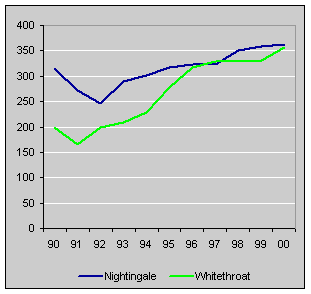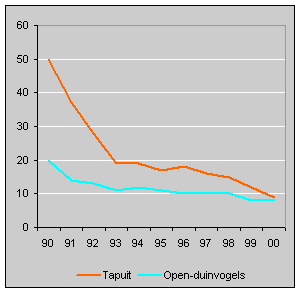More brush, fewer wheateaters in Dutch dunes

As the area covered by bushes and shrubs in the Dutch dunes has increased since 1950, the numbers of bird species living in this habitat, such as the nightingale and the whitethroat have also risen. The numbers of breeding bids in open dune land, such as the wheatear, the curlew, the skylark, the redshank and the black-tailed godwit, on the other hand have declined since 1950, and are still decreasing. The wheatear has all but disappeared from the Dutch dunes in recent years. This is one of the changes in Dutch wildlife described in the recently published Wildlife compendium.
Increase in numbers of nightingale and whitethroat, 1950=100

Bushes and grass
The decline in the number of birds living open dune habitats is a consequence of the increasing area covered by bushes and grass in the dunes, which in turn is the result of increasing nitrogen deposits (from air pollution) and the decline of the rabbit population. This encroaching vegetation means there are fewer suitable nesting places for birds which prefer open dune habitats.
Decline of open-dune birds, 1950=100

It is precisely these open-duneland species that are among the most threatened in the Netherlands. Indeed, the present policy of the dune wildlife protection services aims to keep duneland open and push back grass growth by mowing and grazing. Although grazing does have favourable effects on the vegetation structure in the dunes, it does not always lead to a recovery in the number of open-dune birds.
Lodewijk van Duuren